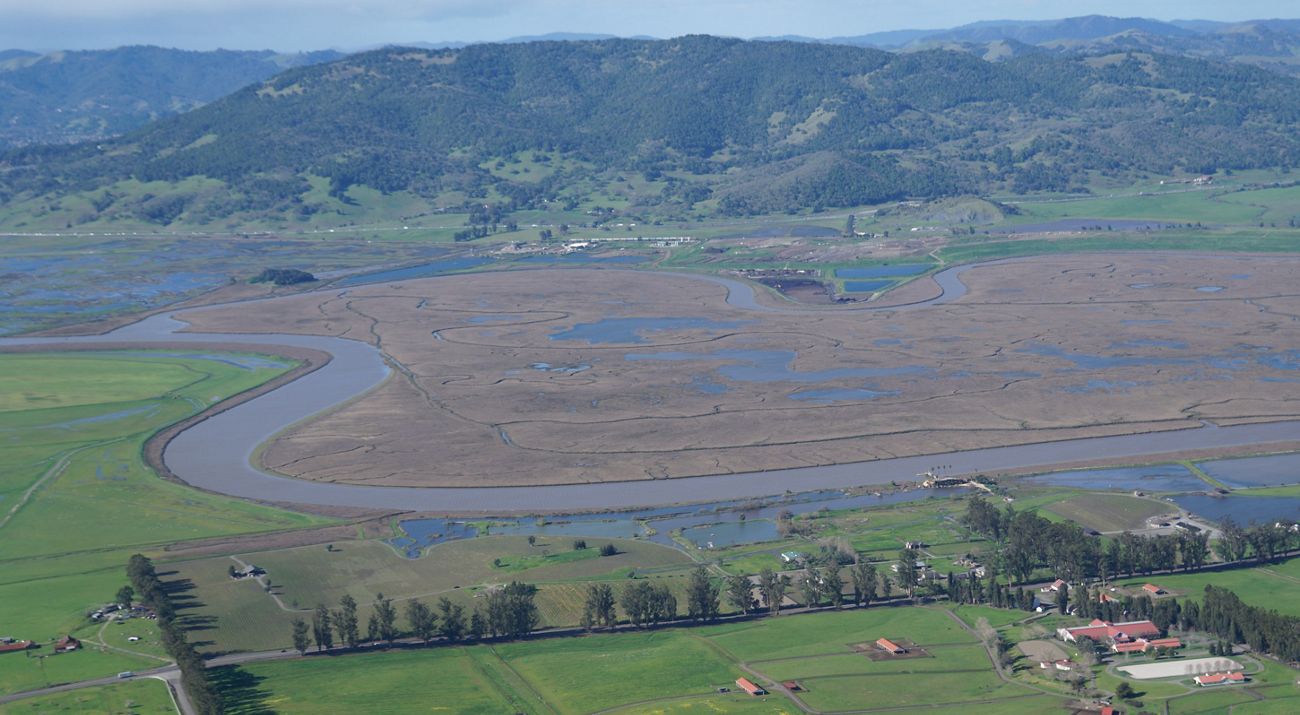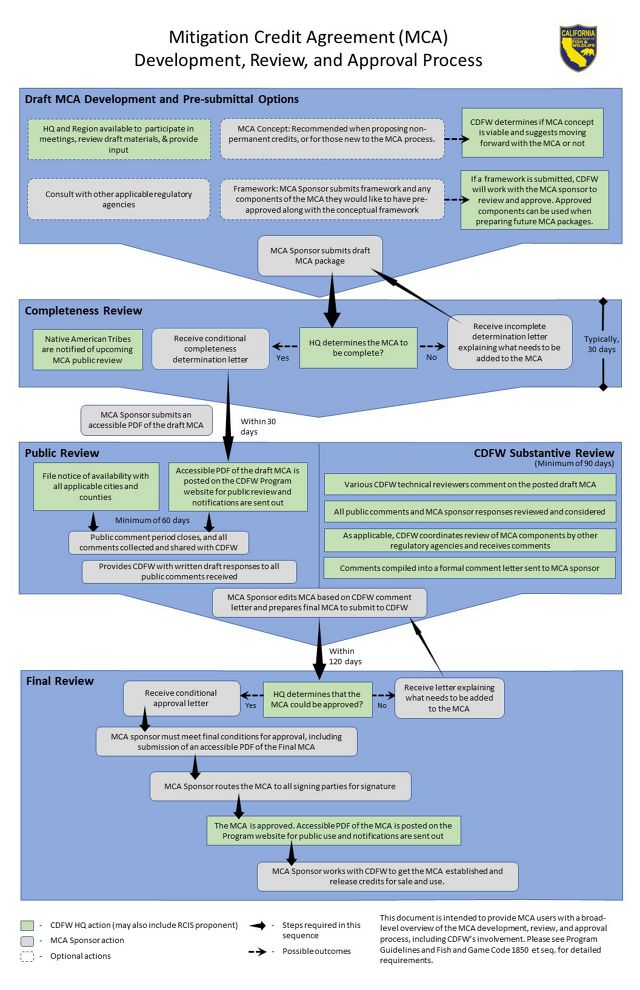Developing an MCA
Key steps in developing an MCA and CDFW’s approval process

Developing a Mitigation Credit Agreement
Once you have decided that an MCA meets your goals and needs, you can begin the MCA development process. This section outlines steps for developing an MCA and the CDFW approval process. Consult with CDFW and other potential acknowledging agencies during the RCIS development to ensure the protected species and habitat types your project would benefit are addressed within the scope of the RCIS.
Launching the MCA Process
Drafting an MCA requires being familiar with the approved RCIS that the MCA will be established under, working with potential partners to determine their roles, and following the MCA Guidelines, checklist and templates when preparing the draft MCA. (See CDFW’s MCA website for resources here.)
To establish an MCA, CDFW will follow the below four steps:
- Draft MCA Development and Pre-submittal Requirements
- Completeness Review
- Public Review
- Final Review
Steps for Developing a draft MCA
Basic Process
-
First, review the MCA section of the RCIS Program Guidelines (Section 5) to understand the process, options, requirements and recommendations. In addition to the Guidelines, CDFW provides a list of resources on its MCA webpage that are helpful to review and important to follow. From presentation recordings and webinar slide decks to MCA templates, a checklist, reference guides, and the fee schedule, these resources will help you prepare and organize your process.
Be sure to become familiar with the RCIS for the region in which your MCA project site(s) will be located so you can ensure that the conservation and habitat enhancement actions you will be implementing can generate the credits.
It’s important to be realistic about the timeline for development, approval, and implementation of an MCA (including Concept and Framework). As a new tool, the process for development and approval are in the initial stages, and CDFW and MCA sponsors are working together to make the process more efficient. The timeline for developing and getting MCA approval varies depending on your knowledge, resources, and motivation, the type of MCA you are considering, and the scope and scale of your proposed action(s).
Take advantage of CDFW’s offer to meet early during the scoping phase to help you better understand the development process and how the MCA can meet your needs.
-
First, decide what MCA option best fits your situation and needs: an MCA Concept, MCA, MCA Framework, or Connectivity Advance Mitigation MCA. Become familiar with each option in the MCA Summary and Feasibility Assessments section of this website. The more information you have about your site(s) and situation, the easier it will be to identify the best pathway for meeting your goals and needs. CDFW is willing and able to meet with you to help you consider your options and determine the best approach and products to develop.
It’s also critical to determine what entity will fill each MCA role. While the MCA sponsor leads the effort to develop an MCA, there are other specific roles and responsibilities that need to be identified to establish a successful MCA. For example, identify the entity that implements and is the long-term steward of the projects and properties (i.e., land manager); the funder; the property owner/easement holder and the MCA review team. Consider the market for credits and potential credit users/purchasers (if not solely for your own use) and engage with those entities in the development of the MCA.
In addition to potential partners, it’s important to engage CDFW, and other regulatory agencies who you may want to sign onto or accept the MCA credits, early and often. Providing an outline of the MCA project components (e.g., site location, proposed enhancement actions, or conservation goals) so that they may review and contribute to may yield the most effective and regionally suitable MCA.
Assemble resources to develop an MCA, including the fee for submission to CDFW, and a financial plan to support the implementation of the actions in the MCA that will result in credit creation. Consultants can help develop the MCA if you are capacity-constrained or lack the expertise.
Learn more about the various MCA products, market demand for credits, potential partners, resources, and other information, in the MCA Feasibility Assessment section of this website.
-
An MCA engagement strategy is critical to meeting your needs, understanding the market, and for the MCA to be accepted by CDFW and other regulatory agencies.
As mentioned throughout this website, it is important to engage early with all potential regulatory agencies (i.e., federal, state, and local) to ensure the appropriate regulatory mitigation requirements and policies are included in the MCA design.
It’s helpful to review the MCA Engagement section of this Website for more information, including the MCA Engagement presentation, which includes a summary of the engagement requirements and recommendations.
-
If you have not already consulted with CDFW, be sure to do so before you begin drafting the MCA, as they will learn more about your MCA goals and intentions and can give you valuable advice. In addition, be sure to review Section 5.5 of the RCIS Guidelines, “MCA Development, Review and Approval Process,” to understand your requirements and options.
Drafting the MCA involves following the MCA template and appropriate checklist, inputting the information as required, and cross-checking the underlying RCIS to ensure consistency. There are several decisions to make that will help create your desired outcome. These decisions include credit types, uses, and timing needs, funding considerations, and partner needs. These decisions may help you determine which MCA product you want to initiate.
For example, the MCA sponsor must include a credit release schedule that considers the credit types, when they are needed, and the performance standards that need to be met for each credit release. These decisions have implications on the need for securities, so understanding the tradeoffs of certain decisions is important.
Engaging with partners and agencies is very helpful throughout the process, to refine roles and responsibilities, to consider tradeoffs together, and to ensure that the MCA will have the outcomes that the sponsor and partners expect. Site visits can also be helpful to build deeper understanding and provides an opportunity to collaborate with potential partners and coordinate with CDFW and other agencies.
As the process can be intensive, consultants can provide valuable capacity to draft the MCA, provide strategic advice, and/or organize meetings if the MCA sponsor lacks the capacity themselves. Check out the list of consultants in the Resources section of this website.
-
CDFW has outlined the process for review and approval in Section 5.5 of the RCIS Guidelines, including a schematic “MCA Development, Review and Approval Process,” which you can see below.
The process includes submitting the MCA document with the appropriate CDFW fee, receiving feedback from CDFW and holding follow-up meetings to dive into specific issues and concerns as necessary. Note the public notice requirements and timing of CDFW review.
CDFW is available to consult with you at all stages, from the very beginning as you are considering developing an MCA, and throughout to answer questions, help guide thinking and provide feedback.
-
The information in the MCA will guide the implementation plan. For example, it will identify:
- The conservation and/or habitat enhancement action(s) that will be taken, the schedule, and the permits and authorizations needed.
- Credit information, such as the credit type(s), quantity, sale and use, proposed service areas, the credit release schedule and reporting method.
- The development plan, including the metrics or indicators that demonstrates the actions that contribute to achieving the RCIS’s goals and objectives.
- The real estate instrument for protection activities.
- Financial securities and funding that will be needed and are secured, including for long-term stewardship.
- Interim and long-term management and monitoring plan.
While CDFW is the lead agency approving the MCA, other federal, state and local agencies can participate in the MCA by approving or accepting credits at their discretion. It’s best to work with other agencies while you are developing the MCA so you can understand their perspective and incorporate their interests, priorities and policies into the MCA.
Once the MCA is approved, the work follows. For example, you may need to secure the necessary permits and approvals for your actions, including for restoration and habitat enhancement activities. Under CDFW’s Cutting the Green Tape program, restoration and habitat enhancement activities may be eligible for strategies that accelerate the pace and scale of restoration throughout the State, such as the CEQA Statutory Exemption for Restoration Projects (SERP).
Implementing the conservation and/or habitat enhancement action(s) is the primary goal of the MCA. It’s beneficial to adaptively manage the project(s), allowing for adjustments based on data and changing environmental conditions. The MCA will outline the milestones and credit release schedule associated with the action(s).
Throughout the process and following completion of the actions, the MCA sponsor will need to monitor the site(s) regularly and track the success of the mitigation project(s), according to the interim and long-term management and monitoring plan.
The MCA sponsor can use the credits for their own purposes or sell them to others who are in need of the credits. The MCA sponsor tracks their credits and provides reports to CDFW who will post the information on CDFW’s MCA webpage as the credits are generated and sold.

This graphic shows the development, review, and approval process for a Mitigation Credit Agreement. It visually depicts the main phases, including draft MCA development and pre-submittal options; completeness review, public review, CDFW substantive review, and final review.